You'll find powerful natural fixatives to make your DIY fragrances last longer in these ten plant-based preservatives: frankincense resin, benzoin, myrrh, vetiver root, sandalwood, oud, oakmoss, Peru balsam, cedarwood oil, and vanilla bean. Each brings unique protective properties – from benzoin's antimicrobial benefits to myrrh's antioxidant compounds. These botanical treasures have preserved precious scents for centuries, and understanding their secrets will transform your natural perfumery journey.
Frankincense Resin: Ancient Wisdom for Modern Fragrances

While frankincense resin has become a staple in modern perfumery, its rich history dates back thousands of years. You'll find this precious resin was once valued more than gold, with ancient Egyptians, Greeks, and Romans using it extensively for religious ceremonies, embalming, and medicinal purposes. The discovery of these valuable properties was made possible by early civilizations experimenting with heat and fire.
In your DIY fragrance journey, you'll discover frankincense's complex woody, piney, and balsamic notes that can add remarkable depth to your creations. It's particularly effective when you're aiming to create spicy or woody scents, and it blends beautifully with citrus, floral, and earthy oils.
Beyond its aromatic properties, you'll benefit from its natural preservative qualities, as frankincense contains antiseptic properties that have stood the test of time. This makes it an excellent choice for extending the shelf life of your homemade fragrances.
Benzoin's Protective Properties in Natural Perfumery
You'll find benzoin's rich history stretches back thousands of years, when ancient civilizations discovered its remarkable protective qualities for both spiritual and practical applications.
When you're creating natural perfumes, you can rely on benzoin's fixative properties to extend the life of your fragrances while simultaneously providing antimicrobial benefits that ward off spoilage. For optimal results, dissolve benzoin in ethanol-based solutions only, as it won't properly integrate with fixed oils.
Beyond preservation, you're tapping into benzoin's sweet, vanilla-like aroma that adds depth to your compositions while helping other scent ingredients blend harmoniously.
Benzoin's Ancient Origins
Deep within the lush forests of Southeast Asia, particularly in Sumatra, Indonesia, Malaysia, and Thailand, the Styrax benzoin tree produces a valuable resin that has shaped the history of natural perfumery.
You'll find benzoin's rich heritage stretches back centuries, where it played a vital role in traditional medicine, religious ceremonies, and aromatic practices. To harvest this precious resin, collectors make careful incisions in the tree's bark, allowing the fragrant substance to flow out naturally.
The resin's warm, balsamic, and vanilla-like aroma has made it indispensable in creating incense and perfumes throughout history. As an essential base note fixative, benzoin helps extend the longevity of other fragrance ingredients in perfume compositions.
When you explore benzoin's cultural significance, you'll discover its versatility extends beyond just fragrance – it's been a cornerstone in healing practices, preservation methods, and spiritual rituals across various cultures.
Natural Preservation Methods
As natural perfumers seek effective preservation methods, benzoin resin stands out as one of the most versatile fixatives in DIY fragrances. You'll find its antibacterial and antifungal properties vital for protecting your natural perfume compositions while extending their shelf life.
| Property | Benefit |
|---|---|
| Fixative Action | Slows essential oil dispersion |
| Chemical Structure | Contains benzoic acid & vanillin |
| Preservation Power | Fights bacteria & fungi |
When you're creating natural fragrances, benzoin's ability to anchor middle notes while preventing the suppression of other aromatics makes it invaluable. Its sweet, vanilla-like aroma enhances your final composition, and its natural antiseptic properties guarantee your creation stays fresh longer. While it won't dissolve in carrier oils, you can effectively use it in alcohol-based perfumes to lock in scents and maintain their integrity.
The Power of Myrrh as a Natural Stabilizer
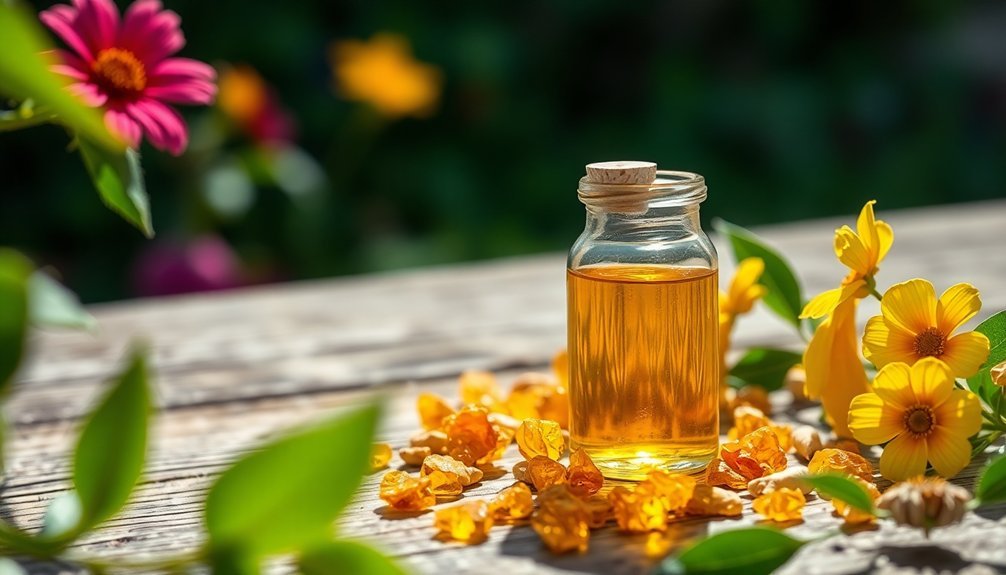
You'll find Myrrh's rich five-millennium history as a preservative mirrors its modern applications in natural perfumery, where its potent antimicrobial properties help extend the life of DIY fragrances.
Its complex chemical structure, packed with antioxidants and protective compounds, makes it an exceptional stabilizer when combined with essential oils and other botanical ingredients.
When you're creating natural perfumes, you can pair Myrrh with fellow fixatives like benzoin or vanilla to enhance both longevity and depth while maintaining the integrity of your fragrance blend.
Historical Uses of Myrrh
Throughout history, myrrh has proven itself to be more than just a fragrant resin, serving as a powerful natural preservative that shaped ancient civilizations. You'll find its most notable application in ancient Egyptian mummification, where it prevented decay and maintained bodily integrity.
| Use | Application |
|---|---|
| Medical | Wound care, digestive issues, oral health |
| Spiritual | Temple incense, religious ceremonies, gifts |
| Practical | Insect repellent, perfumes, cosmetics |
Beyond preservation, myrrh's versatility made it worth its weight in gold. It was a cornerstone in traditional medicine, with practitioners like Hippocrates prescribing it for various ailments. From the temples of Jerusalem to the trade routes of the Silk Road, myrrh's significance transcended cultures. You'll recognize its enduring importance in religious contexts, particularly as one of the three gifts presented to baby Jesus.
Chemical Properties and Benefits
When examining myrrh's molecular structure, its remarkable stabilizing properties become clear. This ancient resin contains 2-10% volatile oils, rich in sesquiterpenes, alongside water-soluble gums and ethanol-soluble resins that make it perfect for preserving fragrances.
You'll find that myrrh's chemical composition provides multiple benefits for your DIY perfumes. Its furanosesquiterpenes don't just create that distinctive aroma – they also act as powerful stabilizers.
The resin's ability to form chemical bonds through its amine and carboxylate groups helps maintain fragrance integrity, while its antioxidant properties protect against degradation.
When you're creating natural perfumes, myrrh's antimicrobial qualities will help prevent unwanted bacterial growth. Plus, its excellent dispersion properties guarantee your fragrance stays properly blended without separation or precipitation over time.
Blending With Other Fixatives
Blending myrrh with complementary fixatives creates a powerful synergy that elevates your DIY fragrances to new heights. You'll find that myrrh's exceptional stabilizing properties work particularly well with frankincense, creating a lasting foundation for your signature scents.
| Fixative Type | Best Pairings | Recommended Ratio |
|---|---|---|
| Citrus | Mandarin, Bergamot | 2-3 drops per tbsp |
| Floral | Rose, Jasmine | 3-4 drops per tbsp |
| Spicy | Peppermint, Tea Tree | 2-5 drops per tbsp |
| Base Notes | Frankincense, Vanilla | 4-5 drops per tbsp |
When creating your blends, start with small amounts of myrrh – its potent nature means a little goes a long way. You can enhance your DIY lotions and perfumes by adding 10-40 drops to your base mixture, ensuring your fragrances maintain their integrity throughout the day.
Vetiver Root: Earth's Time-Released Fixative
Nature's aromatic anchor, vetiver root emerges from the deep-growing grass Vetiveria zizanioides with an extraordinary ability to fix and enhance fragrances.
You'll find its complex scent profile combines woody, earthy, and smoky notes with subtle floral undertones, making it perfect for DIY perfumes.
When you're creating natural fragrances, you can count on vetiver's remarkable fixative properties to extend the longevity of your blends.
Its versatility lets you pair it with everything from jasmine and rose to bergamot and cedarwood.
You'll need to source authentic vetiver oil, as there's no synthetic alternative due to its intricate chemical composition.
For best results, use vetiver as a base note – its time-released properties will help your fragrance unfold gradually while maintaining its integrity throughout the day.
Sacred Sandalwood: Nature's Fragrance Keeper

A treasure among fragrance preservatives, sandalwood oil stands as one of the most revered natural fixatives in perfumery. Its high concentrations of alpha and beta-santalol give it exceptional staying power, allowing your DIY fragrances to retain their scent for years when properly stored.
You'll find that sandalwood's fixative properties work beautifully with other essential oils, particularly rose, frankincense, and myrrh. When you're creating your own perfume blends, add sandalwood as a base note to anchor lighter, more volatile scents.
Beyond its preservative qualities, you'll benefit from its natural antiseptic and anti-inflammatory properties, making it an excellent choice for skin-safe formulations.
While pure sandalwood oil can be expensive due to sustainability concerns, you can opt for quality synthetic alternatives that offer similar fixative benefits.
Vanilla Bean: Sweet Protection for Your Scents
Your DIY fragrances can benefit from vanilla bean's remarkable fixative properties, which help lock in scents while providing natural antimicrobial protection.
When you incorporate vanilla into your fragrance blends, its compounds work as preservatives that extend the life of your essential oil mixtures by inhibiting microbial growth.
The heat from your skin gradually releases vanilla's aromatic compounds throughout the day, creating a long-lasting scent that maintains its integrity over time.
Vanilla's Natural Fixative Properties
The gentle sweetness of vanilla extends far beyond its familiar aroma – this versatile ingredient serves as a powerful natural fixative in DIY fragrances. When you're creating your own scents, vanilla's unique molecular properties help reduce the volatility of other fragrance compounds, making your blends last considerably longer.
You'll find that vanilla works quietly in the background, enhancing the intensity of other aromas while maintaining their harmony.
Whether you choose Madagascar Bourbon, Tahitian, or Indonesian vanilla, you can blend it with essential oils like sandalwood and ylang ylang for complex, enduring scents. For best results, use vanilla as a base note and combine it with other fixatives such as tonka bean absolute.
Don't forget to let your blended fragrance age – this step maximizes vanilla's preservative qualities and deepens the overall scent profile.
Extended Release Through Heat
While many fragrances dissipate quickly in heat, vanilla bean offers unique protection against thermal breakdown, making it an ideal natural preservative for DIY perfumes. You'll notice that when you combine vanilla with heat-activated fragrances, it helps maintain the scent's integrity while allowing for controlled release through body temperature.
| Heat Effect | Without Vanilla | With Vanilla |
|---|---|---|
| Evaporation | Rapid loss | Controlled release |
| Oxidation | Quick breakdown | Stabilized molecules |
| Longevity | 2-3 hours | 6-8 hours |
To maximize vanilla's heat-protective properties, you'll want to blend it into your base notes. This creates a foundation that anchors more volatile top notes, preventing their rapid evaporation during physical activity. The result is a fragrance that maintains its complexity and responds naturally to your body's warmth throughout the day.
Oud's Molecular Magic in Scent Preservation
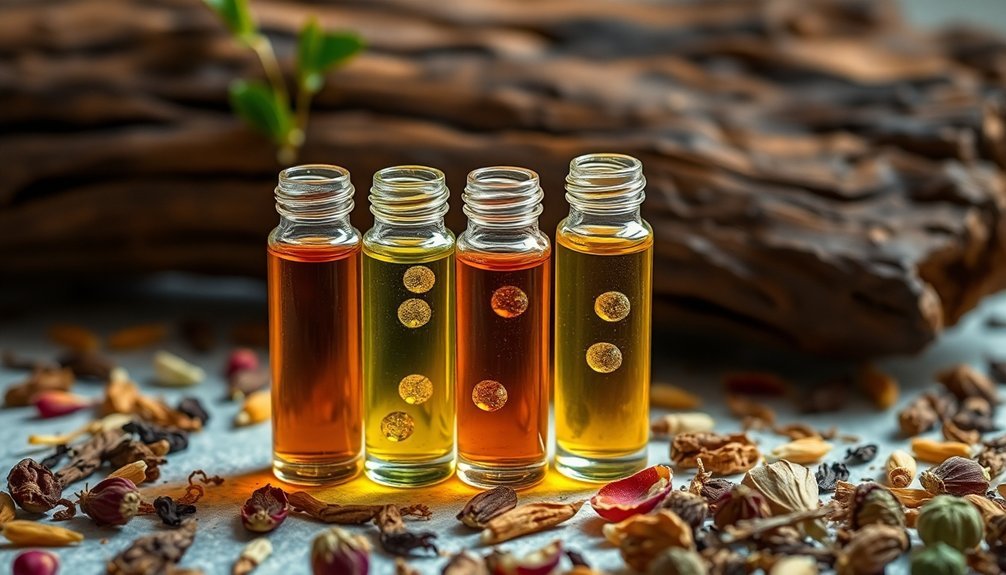
Delving into oud's molecular structure reveals a fascinating interplay of compounds that create its legendary staying power.
You'll find that sesquiterpenes, particularly agarofurans and their lactone variants, work together to maintain the fragrance's intensity over time.
When you're crafting DIY fragrances with oud, you're tapping into nature's most sophisticated preservation system.
The high concentration of aromatic compounds, including specific phenols like 3-(n-propyl)phenol and 3-ethylphenol, creates a robust molecular framework that resists degradation.
To maximize these natural preservative qualities, you'll need to store your oud-based creations properly.
Keep them away from light, heat, and excess air exposure.
Oakmoss: The Forest's Gift to Fragrance Longevity
Nature's remarkable gift of oakmoss stands as one of perfumery's most treasured preservatives. This complex lichen, formed through a symbiotic relationship between fungi and algae, offers an unmatched ability to extend your fragrance's life through its exceptional fixative properties.
You'll find oakmoss's unique molecular structure, composed of roughly 80 distinct substances, helps lock in other scent molecules while adding its own earthy, forest-like aroma to your DIY creations.
When you're crafting natural perfumes, you can depend on oakmoss as a base note that pairs beautifully with florals, citrus, and vanilla while simultaneously preserving their volatile compounds.
Remember to source your oakmoss responsibly, as sustainable harvesting practices guarantee this precious ingredient remains available for future generations of natural perfumery.
Peru Balsam: Traditional Botanical Preservation
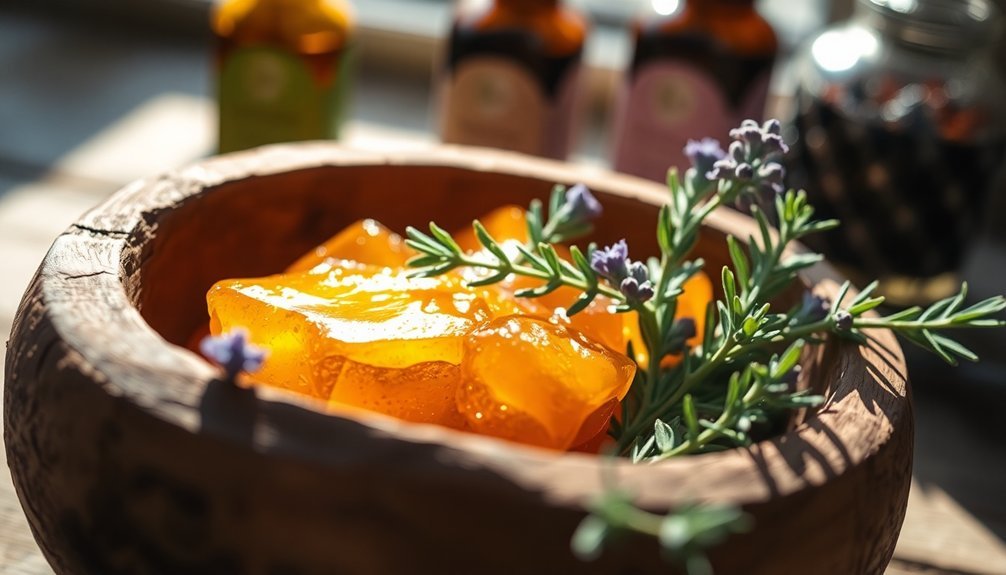
Deep in the heart of El Salvador grows the majestic Myroxylon balsamum tree, source of one of perfumery's most versatile preservatives: Peru Balsam. When you're crafting DIY fragrances, you'll find this rich, dark resin invaluable for its dual role as both a fixative and preservative.
You'll discover Peru Balsam's complex chemistry, featuring over 25 compounds including cinnamein and benzyl benzoate, works to stabilize your fragrance while adding sweet, honey-like notes with vanilla undertones.
The resin's natural antiseptic properties help protect your creations from bacterial growth, extending their shelf life naturally.
To harness its benefits, add small amounts to your perfume formulations. You'll notice it not only preserves the scent but also adds depth with its warm, balsamic character that complements both floral and woody compositions.
Cedarwood Oil: Timeless Aromatic Guardian
From ancient temples to modern perfumeries, cedarwood oil has stood as a steadfast guardian of natural fragrance formulations. When you're creating DIY fragrances, you'll find this oil offers dual benefits – it's both a preservative and an active ingredient that enhances your blend's therapeutic properties.
You'll appreciate how cedarwood oil's natural antibacterial properties help protect your fragrance while its antioxidant powers fight free radicals. To maximize its preservative potential, you'll want to combine it with ethanol, which extends shelf life and improves stability.
Since it's highly volatile with poor water solubility, consider using it in nanoemulsion form for better effectiveness.
Beyond preservation, you're getting aromatherapeutic benefits – it soothes skin, promotes scalp health, and adds a rich, woody base note to your fragrance creations.
Frequently Asked Questions
How Long Should I Age My Natural Perfume Before First Use?
You'll want to age your natural perfume for at least 48 hours, but waiting 2-4 weeks will give you better results. For the most complex and harmonious scent, consider aging it for 6 months.
Can I Mix Different Natural Fixatives Together for Stronger Preservation?
Yes, you can mix natural fixatives for enhanced preservation. When you combine fixatives like benzoin, myrrh, and labdanum, you'll get better longevity and stability. Just keep the total concentration between 3-5%.
What Temperature Is Ideal for Storing Plant-Based Perfume Ingredients?
You'll want to store your plant-based perfume ingredients between 15-21°C (59-70°F). Keep them in a cool, dark place away from heat sources and maintain consistent temperatures to prevent degradation of natural compounds.
Does the Moon Phase Affect the Potency of Solar-Infused Fragrances?
Yes, the moon's phase can influence your solar-infused fragrances. You'll get the best results by starting your infusions during the waxing moon and completing them during the full moon for maximum potency.
How Often Should Natural Perfumes Be Rotated or Discarded?
You'll want to rotate your natural perfumes every 1-2 years after opening. Check them regularly for changes in scent or appearance, and discard any that show signs of separation or degradation.
In Summary
You'll find these natural preservatives revolutionize your DIY fragrance creations, making them last longer while keeping them chemical-free. Start experimenting with these plant-based fixatives to discover which combinations work best for your signature scents. Whether you're using frankincense, benzoin, or cedarwood, you're tapping into centuries of aromatic wisdom that'll help your fragrances stay fresh and vibrant naturally.


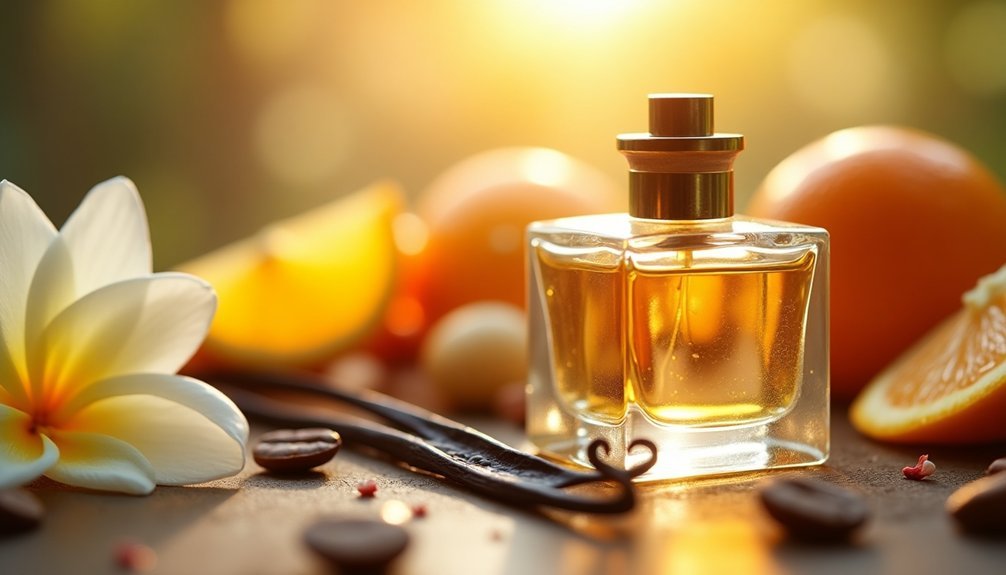

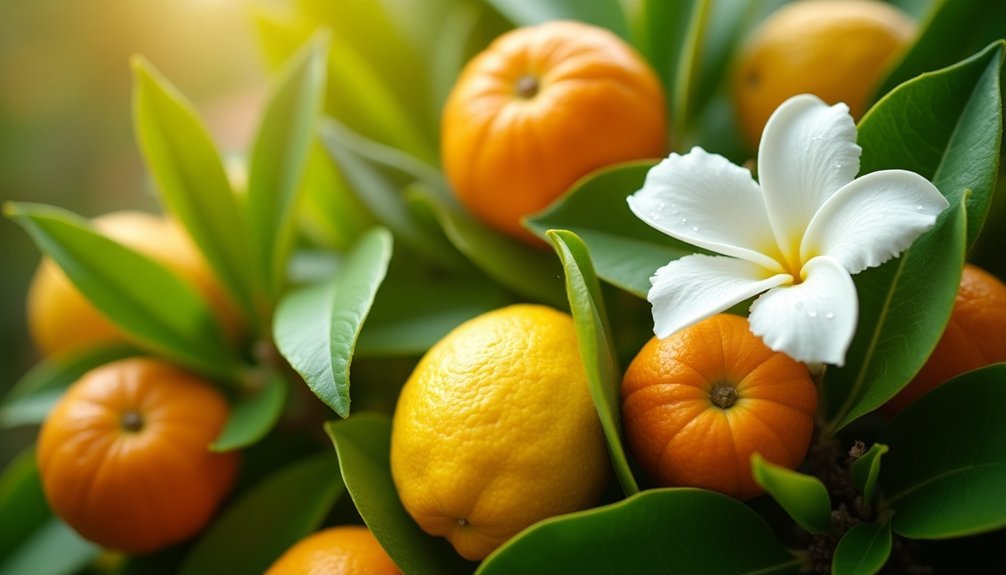
Leave a Reply